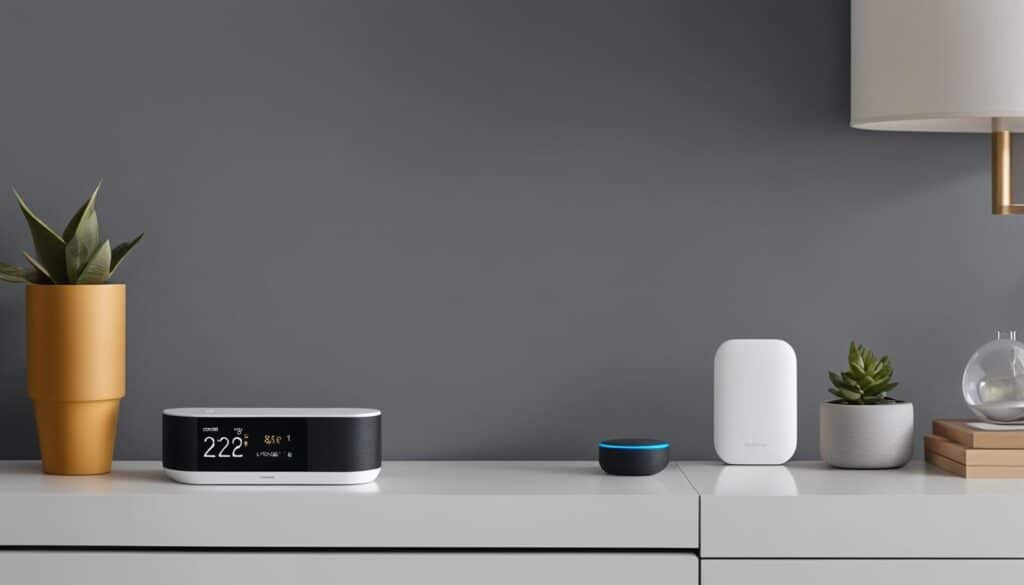Welcome to the world of home automation! As technology advances, so does the convenience and functionality of our homes. One of the key players in this field is Zigbee, a wireless mesh protocol commonly used in smart homes. In this guide, I will walk you through the first steps of setting up an offline smart home using Zigbee technology.
By opting for an offline smart home, you can enjoy enhanced privacy, avoid dependence on third-party servers, and potentially save money. Building your own smart home using Zigbee devices allows you to take control and create a personalized ecosystem that suits your needs.
Table of Contents
Key Takeaways:
- Zigbee is a wireless mesh protocol used in home automation.
- Building an offline smart home offers privacy and independence from third-party servers.
- Zigbee supports a wide range of devices, allowing for a customized smart home experience.
- To build your offline smart home, you’ll need a low-power computer and Zigbee devices.
- Prioritize Zigbee-based devices for faster communication and reliability.
Let’s dive deeper into why building an offline smart home with Zigbee technology is a great choice for home automation enthusiasts like you.
Why Choose an Offline Smart Home?
There are several reasons why building an offline smart home can be advantageous. One of the main reasons is privacy and data security. By avoiding cheaply made devices that connect to the internet, you can minimize the risk of privacy invasions and potential data breaches. Additionally, an offline smart home eliminates the reliance on manufacturer ecosystems, reducing the risk of compatibility issues and unexpected changes in device functionality. Furthermore, offline smart homes are more reliable as they continue to function even without an internet connection.
“An offline smart home provides the peace of mind that your personal data is secure and not susceptible to hacking or unauthorized access. With internet-connected devices, there is always a level of vulnerability, but an offline smart home reduces these risks significantly.” – Smart Home Magazine
Building an offline smart home gives you control over your data and privacy. With no reliance on external servers, you can rest assured that your personal information is secure. Additionally, offline smart homes offer increased reliability. Internet outages or service interruptions won’t affect the functionality of your devices, ensuring your home automation system remains operational at all times.
Table: Advantages of an Offline Smart Home
| Advantage | Description |
|---|---|
| Privacy | Avoid the risk of privacy invasions and potential data breaches. |
| Data Security | Eliminate reliance on manufacturer ecosystems and reduce the risk of compatibility issues. |
| Reliability | Continue to function even without an internet connection, ensuring uninterrupted smart home automation. |
By choosing an offline smart home setup, you can prioritize your privacy, maintain data security, and enjoy a reliable home automation experience. With the control in your hands, you can rest assured that your smart home is working for you, without any compromises.
The Benefits of Zigbee in Home Automation
Zigbee is a wireless mesh protocol that plays a crucial role in home automation ecosystems, powering popular brands such as Philips Hue and IKEA Tradfri. Its versatility and capabilities make it an excellent choice for building a smart home.
One of the standout advantages of Zigbee is its ability to create a brand-agnostic network. This means that devices from different brands can seamlessly work together, eliminating the need for a single ecosystem. Whether you have Philips Hue lights, Nanoleaf panels, Sonos speakers, or Google Nest thermostats, Zigbee integration ensures they all collaborate harmoniously.
With over 2,500 integrations available, Zigbee offers extensive device support. Major brands like Philips Hue have embraced Zigbee, making their products compatible with the protocol. This compatibility extends to various devices, including lights, sensors, switches, and even appliances. By choosing Zigbee-based devices, you can expand your smart home ecosystem without being tied to a specific brand.
Zigbee empowers homeowners to create advanced automations and scenes, enhancing the smart home experience. With the ability to link devices and set up complex routines, you can create personalized automations tailored to your needs. Whether it’s automatically adjusting the lights, temperature, and audio when you arrive home or setting up unique scenes for different occasions, Zigbee delivers a level of customization that transforms your home into a truly smart and intuitive space.
| Benefits | Explanation |
|---|---|
| Brand-Agnostic Network | Seamless integration of devices from different brands |
| Extensive Device Support | Over 2,500 integrations and compatibility with major brands |
| Advanced Automations | Create personalized scenes and routines for a customized experience |
Overall, Zigbee brings unparalleled flexibility and interoperability to home automation. Its wireless mesh protocol enables a brand-agnostic network, supports a wide range of devices, and empowers users to create sophisticated automations. With Zigbee, your smart home can truly be a cohesive and personalized environment.

Building Your Offline Smart Home with Zigbee
To build your own offline smart home using Zigbee, you will need a few key components. First, you will need a low-power computer, such as a Raspberry Pi, to serve as the hub for your smart home system. Additionally, you will need a Zigbee USB dongle to enable Zigbee connectivity. For specific devices, such as smart bulbs, switches, plugs, sensors, robot vacuums, blinds, and other appliances, there are various reputable brands to choose from. Some recommended brands include IKEA Tradfri, Inovelli, Sonoff, Aqara, Xiaomi, and Philips Hue.
| Type of Device | Reputable Brands |
|---|---|
| Smart Bulbs | Philips Hue, IKEA Tradfri, Aqara |
| Switches | Inovelli, Sonoff, Aqara, Xiaomi |
| Plugs | Philips Hue, Sonoff, Aqara, Xiaomi |
| Sensors | Aqara, Xiaomi, Philips Hue |
| Robot Vacuum | Xiaomi, Aqara |
| Blinds | Xiaomi, Ikea Tradfri |
| Appliances | Sonoff, Aqara |
When selecting devices for your offline smart home, it’s important to consider factors such as compatibility, reliability, and affordability. Remember to prioritize Zigbee-based devices over Wi-Fi-based ones for faster and more reliable communication. With the right components and brands, you can create a seamlessly connected and personalized smart home experience.
Choosing the Right Devices for Your Offline Smart Home
When it comes to selecting devices for your offline smart home, it’s important to make informed choices that prioritize reliability, compatibility, and affordability. While there are options available for both Wi-Fi-based and Zigbee-based devices, it is generally recommended to lean towards Zigbee-based devices for a seamless and efficient smart home experience.
The Advantages of Zigbee-Based Devices
Zigbee-based devices offer several key advantages over their Wi-Fi-based counterparts. One of the main benefits is the direct connection to your home automation hub, which enables fast and reliable communication without relying on the brand’s servers. This reduces latency and increases the overall reliability of your smart home system.
Additionally, Zigbee devices create a wireless mesh network, allowing devices to communicate with each other and extend the range of your smart home coverage. This means that even devices situated far away from the hub can still connect and operate efficiently.
Considerations for Wi-Fi-Based Devices
While Zigbee-based devices are generally recommended, it’s important to note that there are still viable options for Wi-Fi-based devices that can be used offline. For example, bulbs with offline firmware from brands like Shelly and Athom can provide offline functionality.
When considering Wi-Fi-based devices, it’s crucial to ensure compatibility with your chosen hub or controller. Some devices may require specific integration or additional hardware, so it’s essential to do thorough research or consult with experts to guarantee a smooth setup.
Factors to Consider
When choosing devices for your offline smart home, it’s important to keep the following factors in mind:
- Affordability: Determine your budget and consider the cost of each device, including any additional required accessories.
- Compatibility: Ensure that your chosen devices work seamlessly with your chosen home automation hub or controller.
- Reliability: Look for devices from reputable brands known for their reliability and durability.
By considering these factors and prioritizing Zigbee-based devices, you can build an offline smart home that offers optimal performance, enhanced reliability, and broader compatibility.

Stay tuned for the next section, where we’ll explore alternatives to Zigbee and discuss emerging technologies like Thread and Matter that may further enhance your offline smart home experience.
Exploring Alternatives: Thread and Matter
As I build my offline smart home, I understand the importance of staying updated on emerging technologies to enhance my home automation system. Two such technologies that hold promise for the future are Thread and Matter.
Thread is a wireless mesh protocol similar to Zigbee, offering the potential for improved connectivity and device integration. While it is still in its early stages, Thread may bring additional benefits, such as extended range and improved reliability. Keeping an eye on the development of Thread can help me leverage its advantages in my smart home setup.
Meanwhile, Matter (formerly known as Project CHIP) is an industry-wide effort to create a unified connectivity standard for smart home devices. Matter aims to simplify device setup and ensure interoperability among different brands and ecosystems. By adopting Matter-compatible devices, I can future-proof my offline smart home and seamlessly integrate them into my existing setup.
In my implementation of Thread and Matter, I rely on my trusty Home Assistant system to manage and control all my smart home devices. The good news is that adding Thread support to Home Assistant is a breeze. I simply plug in a USB dongle that supports Thread, and my smart home system becomes Thread-enabled, opening up new possibilities for device connectivity and automation.
Thread and Matter Integration
Integrating Thread and Matter into my offline smart home offers several advantages. By embracing these wireless mesh protocols alongside Zigbee, I can create a robust and flexible smart home ecosystem that supports a wide range of devices from different brands.
Additionally, Thread and Matter focus on creating open standards, ensuring compatibility and future-proofing my smart home setup. This means that as new devices and technologies emerge, I can easily integrate them into my existing system without the fear of compatibility issues or limited functionality.
Exploring the possibilities of integrating Thread and Matter into my offline smart home allows me to stay ahead of the curve and reap the benefits of cutting-edge technologies in home automation. Keeping abreast of the latest advancements in the world of smart homes ensures that my setup remains versatile, scalable, and future-ready.
Voice Control and Integration with Smart Speakers
Integrating voice control into your offline smart home is easier than ever with the help of existing smart speakers and virtual assistants like Google Assistant, Siri, and Alexa. These popular voice assistants offer seamless integration with a wide range of smart home devices, including those powered by Zigbee technology. With a few simple configurations, you can control all your Home Assistant devices using voice commands, adding a new level of convenience and accessibility to your smart home experience.
Whether you want to turn on the lights, adjust the temperature, or even play your favorite music, voice control allows you to do it all without lifting a finger. Simply activate your preferred smart speaker, such as the Google Nest Hub, Apple HomePod Mini, or Amazon Echo, and issue your desired commands to control your Zigbee-powered devices. The voice recognition capabilities of these smart speakers ensure accurate and reliable execution of your commands, making managing your smart home a breeze.
However, even if you prefer not to rely on voice commands, you can still have manual control over your devices through the use of wireless Zigbee switches. These switches can be strategically placed throughout your home, allowing you to control your lights, scenes, and other connected devices with a simple press of a button. This provides a convenient alternative for those who may have difficulty using voice commands or prefer a more tactile approach to smart home control.
Benefits of Voice Control and Wireless Zigbee Switches:
- Convenient hands-free control of your smart home devices with voice commands
- Seamless integration with popular smart speakers like Google Nest, Apple HomePod, and Amazon Echo
- Enhanced accessibility for individuals with limited mobility or visual impairments
- Manual control through wireless Zigbee switches offers a reliable backup option
- Flexibility to choose between voice control or physical switches based on personal preference
By combining the power of voice control with wireless Zigbee switches, you can create a smart home environment that caters to your unique needs and preferences. Whether you enjoy the convenience of voice commands or prefer the tactile experience of physical switches, these options provide flexibility and accessibility for managing your smart home devices with ease.
Now let’s take a look at a comparison between Google Assistant, Siri, and Alexa in terms of voice control capabilities and compatibility with Zigbee-powered smart speakers:
| Smart Speaker | Voice Assistant | Voice Control Capabilities | Compatibility with Zigbee-powered smart speakers |
|---|---|---|---|
| Google Nest Hub | Google Assistant | Full voice control capabilities | Compatible with Zigbee-powered smart speakers |
| Apple HomePod Mini | Siri | Full voice control capabilities | Compatible with Zigbee-powered smart speakers |
| Amazon Echo | Alexa | Full voice control capabilities | Compatible with Zigbee-powered smart speakers |
With any of these smart speakers and voice assistants, you can enjoy seamless voice control integration with your Zigbee-powered smart home devices. Whether you’re an avid fan of Google Assistant, Siri, or Alexa, you can rest assured that your voice commands will be accurately recognized and executed, bringing your smart home to life with a simple word.
Conclusion
Building an offline smart home with Zigbee technology is a smart choice for anyone looking to enhance their home automation system. With Zigbee’s wireless mesh protocol, you can create a secure and reliable smart home environment that prioritizes privacy and compatibility. By following the steps outlined in this guide, you can take control of your smart home devices and enjoy a personalized home automation experience.
By choosing an offline smart home, you can avoid relying on third-party servers, ensuring that your data remains secure. With Zigbee’s brand-agnostic network, you have the freedom to mix and match devices from different brands seamlessly. Whether it’s smart bulbs, switches, plugs, sensors, or even a robot vacuum, Zigbee offers extensive device support for all your home automation needs.
Embrace the possibilities of home automation and get started with Zigbee today. Build your own offline smart home, and experience the convenience, control, and peace of mind that comes with having a personalized smart home environment. With Zigbee, you can transform your house into a truly smart home, where every aspect can be automated and controlled with ease.
FAQ
What is Zigbee?
Zigbee is a wireless mesh protocol commonly used in home automation systems, such as smart homes. It allows devices from different brands to work together seamlessly and offers extensive device support.
Why should I choose an offline smart home?
Building an offline smart home offers privacy, data security, and reliability. It minimizes the risk of privacy invasions and data breaches, eliminates reliance on manufacturer ecosystems, and continues to function even without an internet connection.
What are the benefits of Zigbee in home automation?
Zigbee serves as the backbone of many home automation ecosystems and offers a brand-agnostic network. It enables extensive device support, advanced automations, and a personalized smart home experience.
How do I build my offline smart home with Zigbee?
To build your own offline smart home using Zigbee, you will need a low-power computer like a Raspberry Pi as the hub and a Zigbee USB dongle for connectivity. You can choose from reputable brands for specific devices like smart bulbs, switches, sensors, and more.
What considerations should I make when choosing devices for my offline smart home?
It is recommended to prioritize Zigbee-based devices over Wi-Fi-based ones for faster communication and reduced reliance on brand servers. Consider factors like affordability, compatibility with your chosen hub, and reliability when selecting devices.
What alternatives should I explore for my offline smart home setup?
You can keep an eye on emerging technologies like Thread and Matter, which offer potential benefits in the future. These wireless mesh protocols can be integrated into your Home Assistant system through a USB dongle.
Can I integrate voice control into my offline smart home?
Yes, you can integrate voice control using existing smart speakers and assistants like Google Assistant, Siri, and Alexa. With configuration, you can control your Home Assistant devices through voice commands. Wireless Zigbee switches are also available for manual control.
How does building an offline smart home with Zigbee benefit me?
Building an offline smart home with Zigbee technology allows you to take control of your home automation system while ensuring privacy, reliability, and compatibility. It provides a personalized and secure smart home environment that meets your needs.


